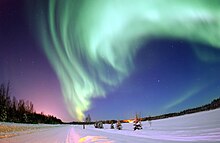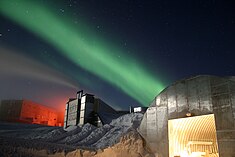Aurora (astronomy)
From Wikipedia, the free encyclopedia
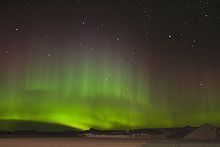
Aurora australis in Antarctica
Auroras, also known as
northern and southern (polar) lights or
aurorae (
singular: aurora), are natural light displays in the
sky, usually observed at
night, particularly in the
polar regions. They typically occur in the
ionosphere. They are also referred to as
polar auroras. This is a misnomer however, because they are commonly visible between 65 to 72 degrees north and south latitudes, which would place it in a ring just within the Arctic and Antarctic circles. Aurorae occur deeper inside the polar regions, but these are infrequent occurrences, and these are often invisible to the naked eye.
In northern
latitudes, the effect is known as the
aurora borealis, named after the
Roman goddess of dawn,
Aurora, and the
Greek name for the north wind,
Boreas, by
Pierre Gassendi in 1621.
[1] The aurora borealis is also called the
northern polar lights, as it is only visible in the sky from the
Northern Hemisphere, with the chance of visibility increasing with proximity to the
North Magnetic Pole. (
Earth's is currently in the arctic islands of northern
Canada.) Auroras seen near the magnetic pole may be high overhead, but from further away, they illuminate the northern horizon as a greenish glow or sometimes a faint red, as if the Sun were rising from an unusual direction. The Aurora Borealis most often occurs near the
equinoxes. The northern lights have had a number of names throughout history. The
Cree call this phenomenon the "
Dance of the Spirits." In the Middle Ages the auroras have been called a sign from God (see Wilfried Schröder, Das Phänomen des Polarlichts, Darmstadt 1984).
Its southern counterpart, the
aurora australis or the
southern polar lights, has similar properties, but is only visible from high southern latitudes in
Antarctica,
South America, or
Australasia.
Australis is the
Latin word for "of the South."
Auroras can be spotted throughout the world and
on other planets. It is most visible closer to the poles due to the longer periods of darkness and the magnetic field.
[edit] Auroral mechanism
Auroras are the result of the emissions of photons in the Earth's upper
atmosphere, above 80 km (50 miles), from
ionized nitrogen atoms regaining an electron, and
oxygen and
nitrogen atoms returning from an
excited state to
ground state. They are ionized or
excited by the collision of
solar wind particles being funneled down and accelerated along the Earth's magnetic field lines; excitation energy is lost by the emission of a photon of light, or by collision with another atom or molecule:
- oxygen emissions
- Green or brownish-red, depending on the amount of energy absorbed.
- nitrogen emissions
- Blue or red. Blue if the atom regains an electron after it has been ionized. Red if returning to ground state from an excited state.
Oxygen is unusual in terms of its return to
ground state: it can take three quarters of a second to emit green light and up to two minutes to emit red. Collisions with other atoms or molecules will absorb the excitation energy and prevent emission. The very top of the atmosphere is both a higher percentage of oxygen, and so thin that such collisions are rare enough to allow time for oxygen to emit red. Collisions become more frequent progressing down into the atmosphere, so that red emissions do not have time to happen, and eventually even green light emissions are prevented.
This is why there is a colour differential with altitude; at high altitude oxygen red dominates, then oxygen green and nitrogen blue/red, then finally nitrogen blue/red when collisions prevent oxygen from emitting anything. Green is the most common of all auroras. Behind it is pink, a mixture of light green and red, followed by pure red, yellow (a mixture of red and blue), and lastly pure blue.

A predominantly red aurora australis
Auroras are associated with the solar wind, a flow of ions continuously flowing outward from the Sun. The Earth's magnetic field traps these particles, many of which travel toward the poles where they are accelerated toward Earth. Collisions between these ions and atmospheric atoms and molecules causes energy releases in the form of auroras appearing in large circles around the poles. Auroras are more frequent and brighter during the intense phase of the solar cycle when
coronal mass ejections increase the intensity of the solar wind.
[2] Seen from space, these fiery curtains form a thin ring in the shape of a
monk's tonsure.
[edit] Forms and magnetism
Typically the aurora appears either as a diffuse glow or as "curtains" that approximately extend in the east-west direction. At some times, they form "quiet arcs"; at others ("active aurora"), they evolve and change constantly. Each curtain consists of many parallel rays, each lined up with the local direction of the magnetic field lines, suggesting that aurora is shaped by Earth's magnetic field. Indeed, satellites show electrons to be guided by magnetic field lines, spiraling around them while moving towards Earth.
The similarity to curtains is often enhanced by folds called "striations". When the field line guiding a bright auroral patch leads to a point directly above the observer, the aurora may appear as a "corona" of diverging rays, an effect of
perspective.
Although it was first mentioned by
Ancient Greek explorer/
geographer Pytheas,
Hiorter and
Celsius first described in 1741 evidence for magnetic control, namely, large magnetic fluctuations occurred whenever the aurora was observed overhead. This indicates (it was later realized) that large
electric currents were associated with the aurora, flowing in the region where auroral light originated.
Kristian Birkeland (1908)
[3] deduced that the currents flowed in the east-west directions along the auroral arc, and such currents, flowing from the dayside towards (approximately) midnight were later named "auroral electrojets" (see also
Birkeland currents).
On 26 February 2008,
THEMIS probes were able to determine, for the first time, the triggering event for the onset of
magnetospheric substorms.
[4] Two of the five probes, positioned approximately one third the distance to the moon, measured events suggesting a magnetic reconnection event 96 seconds prior to auroral intensification.
[5] Dr. Vassilis Angelopoulos of the
University of California, Los Angeles, the principal investigator for the THEMIS mission, claimed, "Our data show clearly and for the first time that magnetic reconnection is the trigger."
[6]
Still more evidence for a magnetic connection are the statistics of auroral observations.
Elias Loomis (1860) and later in more detail
Hermann Fritz (1881)
[7] established that the aurora appeared mainly in the "auroral zone", a ring-shaped region with a radius of approximately 2500 km around Earth's magnetic pole. It was hardly ever seen near the geographic pole, which is about 2000 km away from the magnetic pole. The instantaneous distribution of auroras ("auroral oval",
Yasha/Jakob Feldstein 1963
[8]) is slightly different, centered about 3-5 degrees nightward of the magnetic pole, so that auroral arcs reach furthest towards the equator around midnight. The aurora can be seen best at this time.
[edit] Solar wind and the magnetosphere

Schematic of Earth's magnetosphere
The Earth is constantly immersed in the
solar wind, a rarefied flow of hot plasma (gas of free electrons and positive ions) emitted by the Sun in all directions, a result of the million-degree heat of the Sun's outermost layer, the
corona. The solar wind usually reaches Earth with a velocity around 400 km/s, density around 5 ions/cm
3 and magnetic field intensity around 2–5 nT (
nanoteslas; Earth's surface field is typically 30,000–50,000 nT). These are typical values. During
magnetic storms, in particular, flows can be several times faster; the
interplanetary magnetic field (IMF) may also be much stronger.
The IMF originates on the Sun, related to the field of
sunspots, and its
field lines (lines of force) are dragged out by the solar wind. That alone would tend to line them up in the Sun-Earth direction, but the rotation of the Sun skews them (at Earth) by about 45 degrees, so that field lines passing Earth may actually start near the western edge ("limb") of the visible Sun.
[9]
Earth's
magnetosphere is formed by the impact of the solar wind on the Earth's magnetic field. It forms an obstacle to the solar wind, diverting it, at a distance of about 70,000 km, forming a
bow shock 12,000 km to 15,000 km further upstream. The width of the magnetosphere abreast of Earth, is typically 190,000 km, and on the night side a long "magnetotail" of stretched field lines extends to great distances.
The magnetosphere is full of ions trapped as the solar wind passes the Earth. Perturbations in the solar wind increase this flow of ions. The excess moving along field lines and eventually accelerated toward the poles are responsible for changes in the aurora.
[edit] Frequency of occurrence
Auroras are common near the Poles. They are occasionally seen in temperate latitudes, when a magnetic storm temporarily expands the auroral oval. Large magnetic storms are most common during the peak of the eleven-year
sunspot cycle or during the three years after that peak.
[citation needed] However, within the auroral zone the likelihood of an aurora occurring depends mostly on the slant of interplanetary magnetic field (IMF) lines (the slant is known as B
z), being greater with southward slants.
Geomagnetic storms that ignite auroras actually happen more often during the months around the
equinoxes. It is not well understood why geomagnetic storms are tied to Earth's seasons while polar activity is not. But it is known that during spring and autumn, the interplanetary magnetic field and that of Earth link up. At the
magnetopause, Earth's magnetic field points north. When B
z becomes large and negative (i.e., the IMF tilts south), it can partially cancel Earth's magnetic field at the point of contact. South-pointing B
z's open a door through which energy from the solar wind can reach Earth's inner magnetosphere.
The peaking of B
z during this time is a result of geometry. The IMF comes from the Sun and is carried outward with the solar wind. Because the Sun rotates the IMF has a
spiral shape. Earth's magnetic dipole axis is most closely aligned with the Parker spiral in April and October. As a result, southward (and northward) excursions of B
z are greatest then.
However, B
z is not the only influence on geomagnetic activity. The Sun's rotation axis is tilted 8 degrees with respect to the plane of Earth's orbit. Because the solar wind blows more rapidly from the Sun's poles than from its equator, the average speed of particles buffeting Earth's magnetosphere waxes and wanes every six months. The solar wind speed is greatest — by about 50 km/s, on average — around 5 September and 5 March when Earth lies at its highest heliographic latitude.
Still, neither B
z nor the solar wind can fully explain the seasonal behavior of geomagnetic storms. Those factors together contribute only about one-third of the observed semiannual variations.
[edit] Auroral events of historical significance
The auroras which occurred as a result of the "
great geomagnetic storm" on both August 28 and September 2, 1859 are thought to be perhaps the most spectacular ever witnessed throughout recent recorded history.
Balfour Stewart, in a paper
[10][11] to the
Royal Society on November 21, 1861, described both auroral events as documented by a self-recording
magnetograph at the
Kew Observatory and established the connection between the September 2, 1859 auroral storm and the
Carrington-Hodgson flare event when he observed that “it is not impossible to suppose that in this case our luminary was taken
in the act.” The second auroral event, which occurred on September 2, 1859 as a result of the exceptionally intense
Carrington-Hodgson white light
solar flare on September 1, 1859 produced aurora so widespread and extraordinarily brilliant that they were seen and reported in published scientific measurements, ship's logs and newspapers throughout the
United States, Europe,
Japan and
Australia. It was reported by the
New York Times [12][13][14] that in
Boston on Friday September 2, 1859 the Aurora was "so brilliant that at about one o'clock ordinary print could be read by the
light"
[13][15][16]. One o’clock Boston time on Friday September 2, would have been 6:00 GMT and the self-recording
magnetograph at the
Kew Observatory was recording the
geomagnetic storm, which was then one hour old, at its full intensity; this is amazingly accurate news reporting. Between 1859 and 1862
Elias Loomis published a series of nine papers on the
Great Auroral Exhibition of 1859 in the
American Journal of Science where he collected world wide reports of the auroral event. The aurora is thought to have been produced by one of the most intense
coronal mass ejections in history, very near the maximum intensity that the Sun is thought to be capable of producing. It is also notable for the fact that it is the first time where the phenomena of auroral activity and electricity were unambiguously linked. This insight was made possible not only due to scientific
magnetometer measurements of the era but also as a result of a significant portion of the 125,000 miles (201,000 km) of
telegraph lines then in service being significantly disrupted for many hours throughout the storm. Some telegraph lines however, seem to have been of the appropriate length and orientation which allowed a current (
geomagnetically induced current) to be induced in them (due to Earth's severely fluctuating
magnetosphere) and actually used for communication. The following conversation occurred between two operators of the American Telegraph Line between
Boston and
Portland, Maine, on the night of September 2, 1859 and reported in the
Boston Traveler:
Boston operator (to Portland operator): "Please cut off your battery [power source] entirely for fifteen minutes."
Portland operator: "Will do so. It is now disconnected."
Boston: "Mine is disconnected, and we are working with the auroral current. How do you receive my writing?"
Portland: "Better than with our batteries on. - Current comes and goes gradually."
Boston: "My current is very strong at times, and we can work better without the batteries, as the aurora seems to neutralize and augment our batteries alternately, making current too strong at times for our relay magnets. Suppose we work without batteries while we are affected by this trouble."
Portland: "Very well. Shall I go ahead with business?"
Boston: "Yes. Go ahead."
The conversation was carried on for around two hours using no battery power at all and working solely with the current induced by the aurora, and it was said that this was the first time on record that more than a word or two was transmitted in such manner.
[15] Such events led to the general conclusion that
The effect of the Aurora on the electric telegraph is generally to increase or diminish the electric current generated in working the wires. Sometimes it entirely neutralizes them, so that, in effect, no fluid is discoverable in them . The aurora borealis seems to be composed of a mass of electric matter, resembling in every respect, that generated by the electric galvanic battery. The currents from it change coming on the wires, and then disappear: the mass of the aurora rolls from the horizon to the zenith.[17]
[edit] Origin
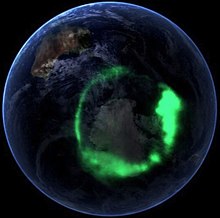
Aurora australis (September 11, 2005) as captured by NASA's
IMAGE satellite, digitally overlaid onto the
The Blue Marble composite image.
An animation created using the same satellite data is also available.
The ultimate energy source of the aurora is the solar wind flowing past the Earth. The magnetosphere and solar wind consist of
plasma (ionized gas), which conducts electricity. It is well known (since
Michael Faraday's [1791 - 1867] work around 1830) that when an electrical conductor is placed within a magnetic field while relative motion occurs in a direction that the conductor cuts
across (or is cut
by), rather than
along, the lines of the magnetic field, an electrical current is said to be induced into that conductor and electrons will flow within it. The amount of current flow is dependent upon a) the rate of relative motion and b) the strength of the magnetic field, c) the number of conductors ganged together and d) the distance between the conductor and the magnetic field, while the
direction of flow is dependent upon the direction of relative motion.
Dynamos make use of this basic process ("the
dynamo effect"), any and all conductors, solid or otherwise are so affected including plasmas or other fluids.
In particular the solar wind and the magnetosphere are two electrically conducting fluids with such relative motion and should be able (in principle) to generate electric currents by "dynamo action", in the process also extracting energy from the flow of the solar wind. The process is hampered by the fact that plasmas conduct easily along magnetic field lines, but not so easily perpendicular to them. So it is important that a temporary magnetic connection be established between the field lines of the solar wind and those of the magnetosphere, by a process known as
magnetic reconnection. It happens most easily with a southward slant of interplanetary field lines, because then field lines north of Earth approximately match the direction of field lines near the
north magnetic pole (namely,
into Earth), and similarly near the
south magnetic pole. Indeed, active auroras (and related "substorms") are much more likely at such times. Electric currents originating in such way apparently give auroral electrons their energy. The magnetospheric plasma has an abundance of
electrons: some are magnetically trapped, some reside in the
magnetotail, and some exist in the upward extension of the
ionosphere, which may extend (with diminishing density) some 25,000 km around Earth.
Bright auroras are generally associated with
Birkeland currents (Schield et al., 1969;
[18] Zmuda and Armstrong, 1973
[19]) which flow down into the ionosphere on one side of the pole and out on the other. In between, some of the current connects directly through the ionospheric E layer (125 km); the rest ("region 2") detours, leaving again through field lines closer to the equator and closing through the "partial ring current" carried by magnetically trapped plasma. The ionosphere is an
ohmic conductor, so such currents require a driving voltage, which some dynamo mechanism can supply. Electric field probes in orbit above the polar cap suggest voltages of the order of 40,000 volts, rising up to more than 200,000 volts during intense magnetic storms.
Ionospheric resistance has a complex nature, and leads to a secondary
Hall current flow. By a strange twist of physics, the magnetic disturbance on the ground due to the main current almost cancels out, so most of the observed effect of auroras is due to a secondary current, the auroral electrojet. An auroral electrojet index (measured in nanotesla) is regularly derived from ground data and serves as a general measure of auroral activity.
However, ohmic resistance is not the only obstacle to current flow in this circuit. The convergence of magnetic field lines near Earth creates a "mirror effect" which turns back most of the down-flowing electrons (where currents flow upwards), inhibiting current-carrying capacity. To overcome this, part of the available voltage appears along the field line ("parallel to the field"), helping electrons overcome that obstacle by widening the bundle of trajectories reaching Earth; a similar "parallel potential" is used in "tandem mirror" plasma containment devices. A feature of such voltage is that it is concentrated near Earth (potential proportional to field intensity; Persson, 1963
[20]), and indeed, as deduced by Evans (1974) and confirmed by satellites, most auroral acceleration occurs below 10,000 km. Another indicator of parallel electric fields along field lines are beams of upwards flowing O+ ions observed on auroral field lines.
While this mechanism is
probably the main source of the familiar auroral arcs, formations conspicuous from the ground, more energy might go to other, less prominent types of aurora, e.g. the diffuse aurora (below) and the low-energy electrons precipitated in magnetic storms (also below).
Some O+ ions ("conics") also seem accelerated in different ways by plasma processes associated with the aurora. These ions are accelerated by plasma waves, in directions mainly perpendicular to the field lines. They therefore start at their own "mirror points" and can travel only upwards. As they do so, the "mirror effect" transforms their directions of motion, from perpendicular to the line to lying on a cone around it, which gradually narrows down.
In addition, the aurora and associated currents produce a strong radio emission around 150 kHz known as
auroral kilometric radiation (AKR, discovered in 1972). Ionospheric absorption makes AKR observable from space only.
These "parallel potentials" accelerate electrons to auroral energies and seem to be a major source of aurora. Other mechanisms have also been proposed, in particular,
Alfvén waves, wave modes involving the magnetic field first noted by
Hannes Alfvén (1942), which have been observed in the lab and in space. The question is however whether these waves might just be a different way of looking at the above process, because this approach does not point out a different energy source, and many plasma bulk phenomena can also be described in terms of Alfvén waves.
Other processes are also involved in the aurora, and much remains to be learned. Auroral electrons created by large geomagnetic storms often seem to have energies below 1 keV, and are stopped higher up, near 200 km. Such low energies excite mainly the red line of oxygen, so that often such auroras are red. On the other hand, positive ions also reach the ionosphere at such time, with energies of 20-30 keV, suggesting they might be an "overflow" along magnetic field lines of the copious "ring current" ions accelerated at such times, by processes different from the ones described above.
[edit] Sources and types
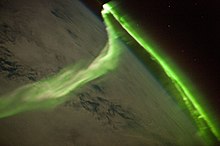
Aurora during a
geomagnetic storm that was most likely caused by a
CME from the Sun on May 24, 2010. Taken from the ISS.
Again, our understanding is very incomplete. A rough guess may point out three main sources:
- Dynamo action with the solar wind flowing past Earth, possibly producing quiet auroral arcs ("directly driven" process). The circuit of the accelerating currents and their connection to the solar wind are uncertain.
- Dynamo action involving plasma squeezed towards Earth by sudden convulsions of the magnetotail ("magnetic substorms"). Substorms tend to occur after prolonged spells (hours) during which the interplanetary magnetic field has an appreciable southward component, leading to a high rate of interconnection between its field lines and those of Earth. As a result the solar wind moves magnetic flux (tubes of magnetic field lines, moving together with their resident plasma) from the day side of Earth to the magnetotail, widening the obstacle it presents to the solar wind flow and causing it to be squeezed harder. Ultimately the tail plasma is torn ("magnetic reconnection"); some blobs ("plasmoids") are squeezed tailwards and are carried away with the solar wind; others are squeezed towards Earth where their motion feeds large outbursts of aurora, mainly around midnight ("unloading process"). Geomagnetic storms have similar effects, but with greater vigor. The big difference is the addition of many particles to the plasma trapped around Earth, enhancing the "ring current" which it carries. The resulting modification of Earth's field allows aurora to be visible at middle latitudes, on field lines much closer to the equator.
- Satellite images of the aurora from above show a "ring of fire" along the auroral oval (see above), often widest at midnight. That is the "diffuse aurora", not distinct enough to be seen by the eye. It does not seem to be associated with acceleration by electric currents (although currents and their arcs may be embedded in it) but to be due to electrons leaking out of the magnetotail.

Any magnetic trapping is leaky—there always exists a bundle of directions ("loss cone") around the guiding magnetic field lines where particles are not trapped but escape. In the
radiation belts of Earth, once particles on such trajectories are gone, new ones only replace them very slowly, leaving such directions nearly "empty". In the magnetotail, however, particle trajectories seem to be constantly reshuffled, probably when the particles cross the very weak field near the equator. As a result, the flow of electrons in all directions is nearly the same ("isotropic"), and that assures a steady supply of leaking electrons.
The energization of such electrons comes from magnetotail processes. The leakage of negative electrons does not leave the tail positively charged, because each leaked electron lost to the atmosphere is quickly replaced by a low energy electron drawn upwards from the ionosphere. Such replacement of "hot" electrons by "cold" ones is in complete accord with the
2nd law of thermodynamics.
Other types of aurora have been observed from space, e.g.
[citation needed] "poleward arcs" stretching sunward across the polar cap, the related "theta aurora", and "dayside arcs" near noon. These are relatively infrequent and poorly understood. There are other interesting effects such as flickering aurora, "black aurora" and subvisual red arcs. In addition to all these, a weak glow (often deep red) has been observed around the two
polar cusps, the "funnels" of field lines separating the ones that close on the day side of Earth from lines swept into the tail. The cusps allow a small amount of solar wind to reach the top of the atmosphere, producing an auroral glow.
[edit] On other planets

Jupiter aurora. The bright spot at far left is the end of field line to Io; spots at bottom lead to
Ganymede and
Europa.
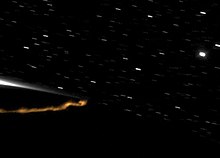
An aurora high above the northern part of Saturn. Image taken by the
Cassini spacecraft spacecraft.
A movie showing images from 81 hours of observations of Saturn's aurora is also available.
Both
Jupiter and
Saturn have magnetic fields much stronger than Earth's (Jupiter's equatorial field strength is 4.3 gauss, compared to 0.3 gauss for Earth), and both have large radiation belts. Aurora has been observed on both, most clearly with the
Hubble Space Telescope. Uranus and Neptune have also been observed to have auroras.
[21]
The auroras on the gas giants seem, like Earth's, to be powered by the solar wind. In addition, however, Jupiter's moons, especially
Io, are powerful sources of auroras on Jupiter. These arise from electric currents along field lines ("field aligned currents"), generated by a dynamo mechanism due to the relative motion between the rotating planet and the moving moon. Io, which has active volcanism and an ionosphere, is a particularly strong source, and its currents also generate radio emissions, studied since 1955. Auroras have also been observed on
Io, Europa, and Ganymede themselves, e.g., using the
Hubble Space Telescope. These are generated when Jupiter's magnetospheric plasma impact their very thin atmospheres.
Auroras have also been observed on Venus and Mars. Because Venus has no intrinsic (planetary) magnetic field, Venusian auroras appear as bright and diffuse patches of varying shape and intensity, sometimes distributed across the full planetary disc. Venusian auroras are produced by the impact of electrons originating from the solar wind and precipitating in the night-side atmosphere. An aurora was also detected on Mars, on August 14, 2004, by the
SPICAM instrument aboard
Mars Express. The aurora was located at
Terra Cimmeria, in the region of 177° East, 52° South. The total size of the emission region was about 30 km across, and possibly about 8 km high. By analyzing a map of crustal magnetic anomalies compiled with data from
Mars Global Surveyor, scientists observed that the region of the emissions corresponded to an area where the strongest magnetic field is localized. This correlation indicates that the origin of the light emission actually was a flux of electrons moving along the crust magnetic lines and exciting the upper atmosphere of Mars.
[21][22]
[edit] History of aurora theories
In the past theories have been proposed to explain the phenomenon. These theories are now obsolete.
- Benjamin Franklin theorized that the "mystery of the Northern Lights" was caused by a concentration of electrical charges in the polar regions intensified by the snow and other moisture.[23]
- Auroral electrons come from beams emitted by the Sun. This was claimed around 1900 by Kristian Birkeland, whose experiments in a vacuum chamber with electron beams and magnetized spheres (miniature models of Earth or "terrellas") showed that such electrons would be guided towards the polar regions. Problems with this model included absence of aurora at the poles themselves, self-dispersal of such beams by their negative charge, and more recently, lack of any observational evidence in space.
- The aurora is the overflow of the radiation belt ("leaky bucket theory"). This was first disproved around 1962 by James Van Allen and co-workers, who showed that the high rate at which energy was dissipated by the aurora would quickly drain all that was available in the radiation belt. Soon afterwards it became clear that most of the energy in trapped particles resided in positive ions, while auroral particles were almost always electrons, of relatively low energy.
- The aurora is produced by solar wind particles guided by Earth's field lines to the top of the atmosphere. This holds true for the cusp aurora, but outside the cusp, the solar wind has no direct access. In addition, the main energy in the solar wind resides in positive ions; electrons only have about 0.5 eV (electron volt), and while in the cusp this may be raised to 50–100 eV, that still falls short of auroral energies.
[edit] Images
Images of aurora are significantly more common today due to the rise of use of
digital cameras that have high enough sensitivities.
[24] Film and digital exposure to auroral displays is fraught with difficulties, particularly if faithfulness of reproduction is an objective. Due to the different spectral energy present, and changing dynamically throughout the exposure, the results are somewhat unpredictable. Different layers of the film emulsion respond differently to lower light levels, and choice of film can be very important. Longer exposures aggregate the rapidly changing energy and often blanket the dynamic attribute of a display. Higher sensitivity creates issues with graininess.
David Malin pioneered multiple exposure using multiple filters for astronomical photography, recombining the images in the laboratory to recreate the visual display more accurately.
[1] For scientific research, proxies are often used, such as ultra-violet, and re-coloured to simulate the appearance to humans. Predictive techniques are also used, to indicate the extent of the display, a highly useful tool for aurora hunters.
[2] Terrestrial features often find their way into aurora images, making them more accessible and more likely to be published by the major websites.
[25] It is possible to take excellent images with standard film (using
ISO ratings between 100 and 400) and a
single-lens reflex camera with full
aperture, a fast lens (f1.4 50 mm, for example), and exposures between 10 and 30 seconds, depending on the aurora's display strength.
[26]
Early work on the imaging of the Aurora was done in 1949 by the
University of Saskatchewan using the
SCR-270 radar.
[edit] In folklore
In
Bulfinch's Mythology from 1855 by
Thomas Bulfinch there is the claim that in
Norse mythology:
- The Valkyrior are warlike virgins, mounted upon horses and armed with helmets and spears. /.../ When they ride forth on their errand, their armour sheds a strange flickering light, which flashes up over the northern skies, making what men call the "aurora borealis", or "Northern Lights".[27]
While a striking notion, there is not a vast body of evidence in the Old Norse literature supporting this assertion. Although auroral activity is common over
Scandinavia and
Iceland today, it is possible that the Magnetic North Pole was considerably further away from this region during the centuries before the documentation of Norse mythology, thus explaining the lack of references.
[28]
The first Old Norse account of
norðrljós is found in the Norwegian chronicle
Konungs Skuggsjá from AD 1230. The chronicler has heard about this phenomenon from compatriots returning from
Greenland, and he gives three possible explanations: that the ocean was surrounded by vast fires, that the sun flares could reach around the world to its night side, or that
glaciers could store energy so that they eventually became
fluorescent.
[29]
In ancient Roman mythology, Aurora is the
goddess of the dawn, renewing herself every morning to fly across the sky, announcing the arrival of the sun. The persona of Aurora the goddess has been incorporated in the writings of
Shakespeare,
Lord Tennyson and
Thoreau.
Modern style guides recommend that the names of meteorological phenomena, such as
aurora borealis, be uncapitalized.
[30]
